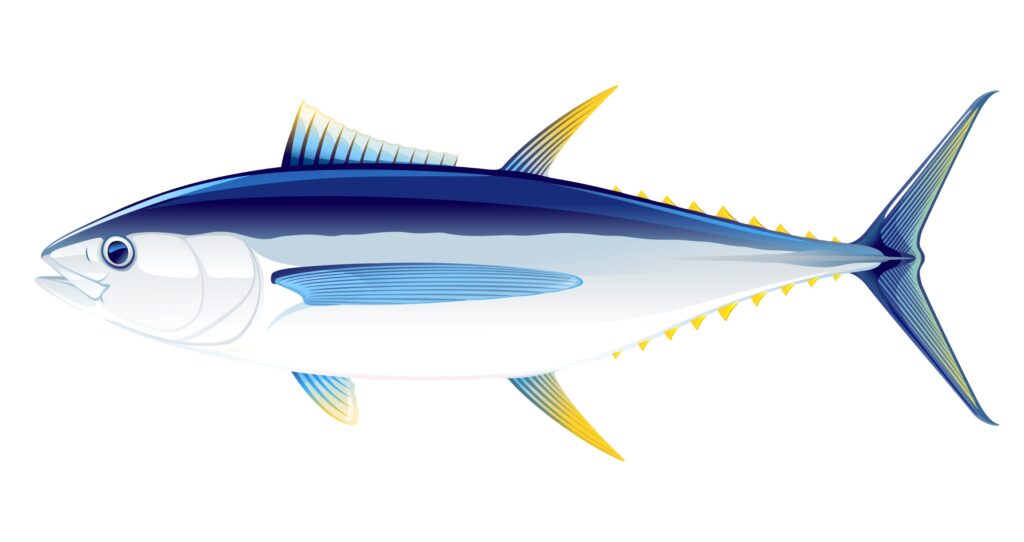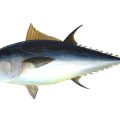Groupers have enormous mouths in comparison to bigeye tunas. The muscles of groupers are white, but those of bigeye tuna are pink to dark red. Bigeye tuna typically live in the water column in self-made burrs.
Bigeye Tuna
Bigeye tuna is a size between bluefin and yellowfin. They have long, streamlined bodies, top sides and backs that are a dark metallic blue, and lower sides and bellies that are almost white. They have a maximum lifespan of 15 years. The sides of live fish exhibit an iridescent blue lateral strip. In comparison to other tuna eyes, this one is very big.
A highly migratory species, bigeye tuna continuously swims over great distances. They can also be found in the waters of other nations in the Pacific and Indian Oceans, though they are most frequently found in the waters of eastern Australia.

Grouper
Groupers are a subfamily of fish called Epinephelinae. All members of this subfamily are groupers, and there are 159 species classified into 15 genera. Groupers have stout bodies and large mouths. Their massive bodies could reach more than a meter in length and weigh up to 100 kilograms. They do not swim long distances. Groupers are predatory fish with a unique adaptation for capturing prey. They are unique in that they do not chase their prey, but rather lie on the water and wait for it to suck into their mouth and swallow.

Scientific Classification
| Scientific Classification | Grouper | Bigeye Tuna |
| Kingdom | Animalia | Animalia |
| Phylum | Chordata | Chordata |
| Class | Actinopterygii | Actinopterygii |
| Order | Perciformes | Scombriformes |
| Family | Serranidae | Scombridae |
| Binomial Name | Epinephelinae | Thunnus obesus |
Bigeye Tuna vs. Grouper Differences
-
- The largest and clearest difference between them is how the user uses them. Bigeye tuna is frequently boiled and sporadically canned before it is made available to consumers. On the other hand, groupers are usually sold alive and aren’t given any special treatment.
-
- The taxonomic variety of groupers is more than three times greater than that of bigeye tuna.
-
- Groupers do not form schools like bigeye tuna does, which is regular.
-
- Groupers can swim, but not as swiftly as bigeye tuna.
-
- Bigeye tuna don’t suckle their prey, but groupers do. They wait for a passing prey item and then use their gill muscles to forcefully suck it into their mouths.
-
- Groupers have broad jaws in comparison to bigeye tuna.
-
- Bigeye tuna has pink to dark red colored muscles as opposed to grouper’s white muscles.
-
- Bigeye tuna typically live in the water column in self-made burrows, more frequently than groupers.
Appearance
Bigeye tuna
-
- Bigeye tuna has a white belly and lower sides and a dark metallic blue back and upper sides.
-
- The finlets on their back are bright yellow with black edges, while the second dorsal and anal fins are pale yellow.
-
- The appearance of the bigeye and yellowfin tuna is comparable. Actually, without experience, it can be challenging to tell the two species apart.
-
- The bigeye differs from the yellowfin in several ways, including having larger eyes and finlets with black edges.
Grouper
-
- Color: brown, yellow, red, black, green.
-
- Skin: Type- Scales
-
- Most Distinctive Feature: A robust body and a huge mouth
-
- They possess lengthy dorsal fins.
-
- Their bodies were covered in tiny dark patches.
-
- Their pelvic fins are smaller and more angular than their pectoral fins.
-
- Nutrition Facts
Bigeye tuna
Bigeye tuna is regarded as a very healthy and lean fish. Bigeye tuna has low sodium and saturated fat content. Additionally, it is a good source of phosphorus, B6, and B12 vitamins. If you’re looking for a natural source of magnesium and omega-3 fatty acids, this fish is a good choice because it also has heart-health benefits.
93 calories are contained in one 3-oz serving of bigeye tuna. One serving contains 0.42 grams of fat and 21 grams of protein. The 0.15 grams of saturated fat in a 2,000-calorie diet account for less than 1% of the daily value (DV). This dish contains 0.10 grams of monounsaturated fat and 0.13 grams of polyunsaturated fat. 33 mg, or 11% of the DV, of cholesterol, is present. Bigeye tuna is devoid of sugar, fiber, or carbohydrates.
Grouper
Grouper is a great source of high-quality protein and other healthy fats, and it is low in saturated fat, which should make up no more than 10% of daily calories and which, if consumed in excess, can be harmful to the heart and arteries.
-
- Total Fat 1.1g. 2%
-
- Saturated Fat 0.3g. 1%
-
- Cholesterol 40mg. 13%
-
- Sodium 45mg. 2%
-
- Potassium 404mg. 12%
-
- Total Carbohydrates 0g. 0%
-
- Dietary Fiber 0g. 0%
-
- Protein 21g.
Facts to Know About Bigeye Tuna
-
- Bigeye tuna can dive deeper than other species of tuna and have a lot of vertical mobility. The movement of this species to deeper waters during the day follows distinct daily patterns.
-
- Tropical waters are where bigeye tuna is most frequently fished.
-
- The record-holder for the largest bigeye tuna recreationally caught in the Atlantic Ocean is a fish that weighed 375 pounds and had a fork length of 6.75 feet that was caught off Ocean City, Maryland, in 1977.
-
- It is thought that bigeye tuna recently diverged from a shared parent population of yellowfin tuna.
-
- Compared to yellowfin tuna, bigeye tuna live longer. The big-eye tuna has a lifespan of up to 12 years and reaches sexual maturity at about four years.
-
- Large billfish and toothed whales are the primary predators of bigeye tuna.
-
- The bigeye tuna plunged into the moon.
Facts to Know About Grouper
-
- Group Behavior: Solitary
- Prey- Other fish, sea turtles, small sharks, crustaceans, octopuses, and zooplankton
- Biggest Threat- Overfishing, habitat destruction
- Habitat- Tropical and subtropical seas
- Diet- Carnivore
- Lifespan- 11-100 years
- Length- between 10 to 12 inches and 8.2 feet
- Fun Fact-Fact: Many groupers can change their sex, and it is always from female to male.
Is Grouper Superior to Bigeye Tuna Nutritionally?
Bigeye tuna is higher in B12, A RAE, B3, Phosphorus, Selenium, B2, B1, B6, B5, and Copper than grouper fish. Bigeye tuna has a 428% higher daily requirement for vitamin B12. Grouper fish does not have the same amount of vitamin B2 as bigeye tuna.
Conclusion
Groupers and bigeye tuna are two important fish species that differ both externally and internally. The family Serranidae, which lives in warmer seas, includes groupers. On the other hand, bigeye tuna belong to the Scombridae family. They differ greatly in the following key areas:
-
- More than three times as many different taxa exist in groupers as in bigeye tuna.
-
- Groupers, unlike bigeye tuna, do not form schools on a regular basis.
-
- Although they can swim, groupers cannot swim as quickly as bigeye tuna.
-
- Bigeye tuna contains more vitamin B2 than grouper fish does.
Between grouper and bigeye tuna, there are some notable differences that have been found. You should now be able to tell a grouper from a bigeye tuna with more ease thanks to this article.











